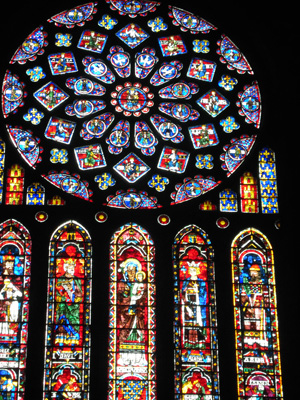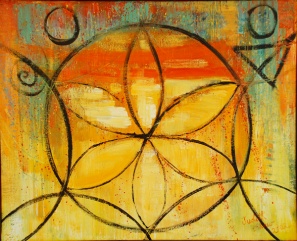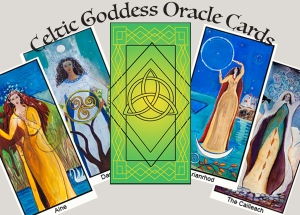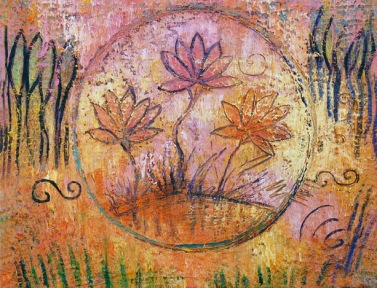
 Can geometry open our hearts and minds to spirit? Throughout time people around the world have thought so. Mandalas and Sacred Geometry symbols are found in many cultures both ancient and modern.
Can geometry open our hearts and minds to spirit? Throughout time people around the world have thought so. Mandalas and Sacred Geometry symbols are found in many cultures both ancient and modern.
Mandala is a Sanskrit word which means “sacred circle.” In Buddhism, Hinduism and other ancient wisdom traditions of the East, the mandala has been used as a tool to facilitate contemplation and meditation. Through the process of studying and/or creating a mandala one can reach one’s center, one’s connection to Source. The circle, the first closed shape of Sacred Geometry, thus becomes a doorway to Oneness.
Traditional Hindu mandalas follow a strict form. Every mandala is created following the precise design of that form. One sees a further development of other Sacred Geometries within these traditional forms. First there is the squaring of the circle also known as “The Marriage of Heaven and Earth”, with the circle representing Heaven and the square representing Earth.
 In the Hindu tradition, each design within this “Marriage of Heaven and Earth” is called a yantra mandala and functions as a symbol which reveals cosmic truths. Thus yantra mandalas become sacred geometric symbols of a particular Hindu deity.
In the Hindu tradition, each design within this “Marriage of Heaven and Earth” is called a yantra mandala and functions as a symbol which reveals cosmic truths. Thus yantra mandalas become sacred geometric symbols of a particular Hindu deity.
One of the most famous yantra mandalas is the Shri Yantra, a symbol of Tripurasundari, a supreme Hindu Tantric Goddess. It depicts a series of precisely interlocking triangles, half pointing downward and half pointing upward. It forms a state of perfect balance and harmony and represents the union of the female and male principles. Also known as the Yantra of Creation or the Cosmic Yantra it is the most honored of all the Hindu yantras. The Shri Yantra becomes a door which can lead to the experience of Oneness.
 Another goddess whose divine truths are revealed through the mandala is Lakshmi, Hindu Goddess of fortune, light, luck, and beauty. Meditating on the Lakshmi Yantra encourages spiritual progress and helps to overcome internal blocks.
Another goddess whose divine truths are revealed through the mandala is Lakshmi, Hindu Goddess of fortune, light, luck, and beauty. Meditating on the Lakshmi Yantra encourages spiritual progress and helps to overcome internal blocks.
Christianity has also used the mandala to represent Divine Oneness and to teach the wisdom of its tradition. The magnificent rose windows of the Gothic cathedrals are luminous examples of western mandalas. Complex sacred geometries were used in the architectural designs of the buildings themselves and of the rose windows.
 The rose windows are a western representation of our human aspiration towards wholeness and balance. The rose windows operate on various levels; spiritual, emotional and intellectual. The instructional aspect of the rose windows is clearly seen by the subject matter – biblical stories, lives of the saints, astrological calendars, and morality stories to name a few.
The rose windows are a western representation of our human aspiration towards wholeness and balance. The rose windows operate on various levels; spiritual, emotional and intellectual. The instructional aspect of the rose windows is clearly seen by the subject matter – biblical stories, lives of the saints, astrological calendars, and morality stories to name a few.
In much the same way that the Hindu yantras symbolize the aspects of a particular deity, the rose windows typically show Christ or the Virgin or some other combination in the central rosette of the window. The gates at the cardinal points of the yantras depict the many paths available to reach the divine. In a similar fashion, the saints shown in the petals of a rose window can be seen as paths to Christ.
More than likely, mandalas were reintroduced into western thought through the Carl Jung’s pioneering work on the unconscious. Jung wrote: “I sketched every morning in a notebook a small circular drawing,…which seemed to correspond to my inner situation at the time….Only gradually did I discover what the mandala really is:…the Self, the wholeness of the personality, which if all goes well is harmonious.”

Continuing in this tradition, artists and spiritual practitioners today have been exploring a more free-form style of the mandala. Within the basic foundation of the “squaring of the circle”, the artist then creates a personal, spontaneous design based on the concepts of balance, wholeness and oneness.
A quick google search reveals a multitude of mandala workshops being offered all around the world. Exploration of the mandala through these workshops offers a connection to your true self, an experience of sacred love, an opportunity to improve your life with intention, a deepening of your connection to nature, healing of emotional, mental, or physical pain, and a chance to be truly in the moment.

 The mandala is a form that I have used in my own art since before I discovered the existence of Sacred Geometry. Even when not directly exploring the mandala, I find that often I want to draw a circle around the main image in my painting – seeking that experience of wholeness in the process of painting.
The mandala is a form that I have used in my own art since before I discovered the existence of Sacred Geometry. Even when not directly exploring the mandala, I find that often I want to draw a circle around the main image in my painting – seeking that experience of wholeness in the process of painting.
In future posts I will explore other elements of Sacred Geometry, all of which grow out of the mandala, the sacred circle.
Sources: http://charlesgilchrist.com/SGEO/AboutMan.html,
http://www.isibrno.cz/~gott/mandalas.htm,
http://www.whats-your-sign.com/yantra-mandala.html,
http://dragon_azure.tripod.com/UoA/Med-Arch-Rose-Window.html,
http://www.sacredsymbolhealingart.com/SacredSymbolhealingArt.com/Mandala_Facilitators.html
Judith’s deck of Celtic Goddess Oracle Cards is available now.  You can order your deck on Judith’s website. Experience the wisdom of the Celtic Goddesses!
You can order your deck on Judith’s website. Experience the wisdom of the Celtic Goddesses!
Judith Shaw, a graduate of the San Francisco Art Institute, has been interested in myth, culture and mystical studies all her life. Not long after graduating from SFAI, while living in Greece, Judith began exploring the Goddess in her artwork. She continues to be inspired by the Divine Feminine in all of Her manifestations. Originally from New Orleans, Judith now makes her home in New Mexico where she paints and teaches part-time. She is currently hard at work on a deck of Goddess cards. Her work, which expresses her belief in the interconnectedness of all life, can be seen on her website.




I love working with mandalas. I’ve found working with Susanne Fincher’s material very rewarding. Some day, I’d like to facilitate a Mandala Circle. The Labyrinth as a mandala one can physically enter and walk through is one of my favorite forms to work with right now.
LikeLike
There is a labyrinth near to my home that I love to walk. But I never connected it with a mandala. But of course! Thank you for enlarging my vision this morning.
LikeLike
Wonderful insights, Kate and Barbara, and now you’ve connected St. Teresa’s INTERIOR CASTLE for me with the Mandala too!! WOW.
LikeLike
What a marvelous post and topic, very refreshing. LOVE those mandalas!! Thanks, Judith for the variety and beauty and the history too!!
I have a huge love of geometric quilt designs, and edit a website on that topic. The traditional patterns date back to the 18th century through the mid 20th century. Each geometric pattern has its own title and most quilters can name many hundreds of designs by sight. None of it is copyrighted, the patterns and their names are simply part of the craft. In fact, there are book compendiums with thousands of historical quilt designs, illustrated and dated, and generously shared for quilters and designers to use as they like. The names of the designs are often ingenious too, for instance — Triangles Askew — Doves in the Window — Caps for Witches and Dunces — Symmetry in Motion — each one a gorgeous geometric abstraction, from the very simple to the most intricate.
LikeLike
A beautiful and inspiring post! Thank you!
LikeLike
Gorgeous illustrations! I always come to FAR right after I turn my computer on in the morning.You’ve got me set up for the day with these mandalas.
I was once present at a ceremony in which Tibetan monks created a mandala with colored sand. It was beautiful. I also watched a group of Native Americans create a mandala with colored sand. Also beautiful. And then, to show the transitoriness of nature, both mandalas were destroyed as the men gathered up the sand and blew it into the wind. I’d really like to watch a group of women create a mandala. (I’ve been present lots of times as Witches and Pagans cast magical circles, but these are invisible to the physical eyes.)
LikeLike
I remember reading that the four T-shapes around the sides of the traditional mandala are four gates . But do they open into the center or do they open into four new dimesions maybe of consciosness outside the mandala?
LikeLike
Thanks to all for your further input about mandalas and how you work with them. I agree – I also see the labyrinth as growing out of the mandala. I’m not familiar with Susanne Fincher’s material or St. Teresa’s Interior Castle – will have to look them up.
Sara, you’ll have to share the quilt website with us someday. It sounds wonderful and I’d love to check it out. I saw an exhibit at the Whitney Museum many years ago of quilts from the 1800 and early 1900’s. They were marvelous. I so love the way crafters have worked without ego, not worrying about if their name is attached to their art or not. It’s a good lesson for “fine” artists.
Barbara, I also saw a group of Tibetan monks create a mandala over a week’s time. Once it was done it was released into the Rio Grande. It was very moving. I believe that the Navajo sand paintings follow that same tradition of using mandala art to express the impermanence of life and the sacred unity of life.
Meg, I believe that the 4 t-shapes you mention are considered to be 4 gates. In the Buddhist tradition the mandalas are always created from the center working outward. So the gates them must be a transition point from the inner to the outer. One source I found says that the 4 gates represent “The four boundless thoughts: loving-kindness, compassion, sympathy and equanimity” and/or
“The four directions: south, north, east and west”
As always, thanks for reading
LikeLike
Oh how blessed the idea of four boundless thoughts!!
Thanks, Judith, for sharing these beauties:
loving-kindness, compassion, sympathy and equanimity
LikeLike
Thanks, Judith — here’s the link for the quilt design website:
Antique Geometric Quilt Designs
http://earlywomenmasters.net/quilts/
LikeLike
Great site Sarah, what a wealth of designs – thanks
LikeLike
Wonderful post, Judith! I’ve been so very into mandalas for a while now, this post confirmed that I need to go get that book I’ve been eyeing up on mandalas and work with them more intensely! Thank you for such an informative and colorful post! ;) Blessed be, sister.
XOXO
Jenn
LikeLike
Great post. Lovely website. I’ve signed up! Thank you for sharing your mandala insights, Judith.
LikeLike
Jennifer, I’m glad the synchronicity of reading my post aligned with your desire to work further with mandalas. Ann, thanks for reading.
LikeLike
Look forward to more in this series! The sacred circle also reminds me of the ancient Celtic circle symbol which indicated a holy place. Christians later added a cross, creating the Celtic cross.
LikeLike
Ferrellink, I did read in my research that the Celtic cross is another example of a Christian mandala. But I did not know about the Celtic circle used to mark a holy place. Thanks for the additional info.
LikeLike